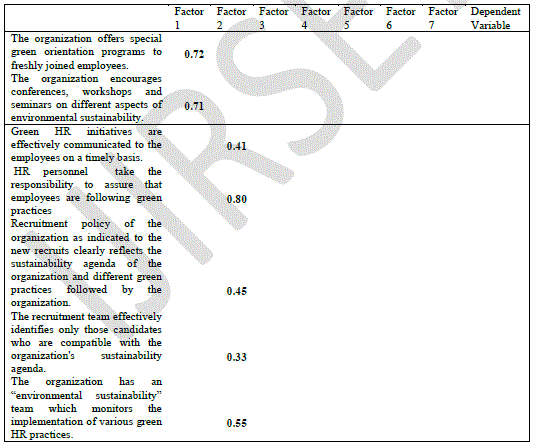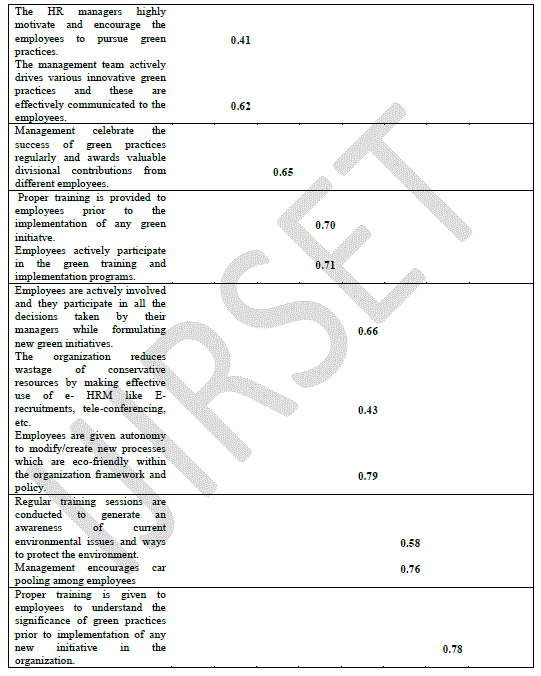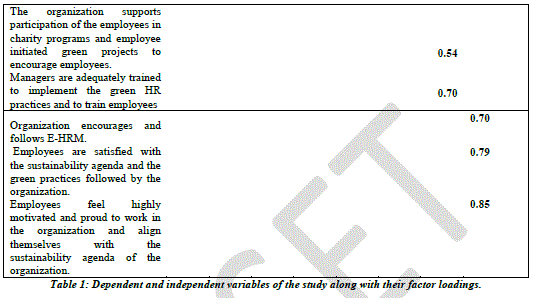ISSN ONLINE(2319-8753)PRINT(2347-6710)
ISSN ONLINE(2319-8753)PRINT(2347-6710)
Dr. J. Venkatesh1, Prof. Lissy.TA2, Prof. Vaishnavi Bhatt3
|
| Related article at Pubmed, Scholar Google |
Visit for more related articles at International Journal of Innovative Research in Science, Engineering and Technology
This study highlights the various green initiatives from the HR functional units pertaining to IT sector in India. The fact that there is a growing concern amongst various companies towards environmental sustainability makes this study most relevant. We used a set of variables, obtained from an Exploratory Factor Analysis, each of which denoted initiatives and practices designed by HR departments across the IT companies in India. Variables like training and development, employee autonomy and E-HRM and Charity programs play a significant role in promoting sustainable development in the organization
KEYWORDS |
| Environmental management, Green HR initiatives, HRM, Sustainable Development. |
I. INTRODUCTION |
| The concept of sustainable development has been highlighted as a major focus in the corporate world today. It enables individuals and companies to meet their current needs without hampering the environment for the future generations to fulfill their needs. Hence companies have now developed a greater sense of responsibility with a greater focus on environmental sustainability, which not only increases the image of the company and the confidence of the investors, but has also become a business imperative. Amongst all the functional departments operating in the organization, the HR function has become one of the important drivers of environmental sustainability. HR managers now have a major role to play in designing efficient strategies which align with the companyâÃâ¬ÃŸs values and culture, investorsâÃâ¬ÃŸ expectations, meeting government rules and regulations, and most importantly, initiate environmental friendly practices and awareness among employees. |
| This paper examines the extent of sustainable development adapted by the IT sector in India. It also analyses the factors which have led to the effectiveness of organizational policy towards green HR initiatives adapted by these organizations in the Indian IT sector. |
II. LITERATURE REVIEW |
| Several measures have been taken by the HR managers in different companies to promote environmental sustainability and increase the responsibility of employees towards environmental management. However, how effectively have these practices been implemented and how have these practices been integrated with the HR departments to achieve overall environmental sustainability is a question for research. Some of the prominently used HR practices to achieve environmental sustainability are discussed in further sections. |
Recruitment |
| It is very important that new recruits into the organization should be selected in such a manner that their individual goals are well aligned with the companiesâÃâ¬ÃŸ green policies. For this the job descriptions of the companies as listed on the websites should have enough clarity which reflects the sustainability agenda and greening endeavors of the organization. Also it is important to note that the employers should examine whether the new recruits have adequate skills which complies with the organizationâÃâ¬ÃŸs requirement and the goal of sustainable development. A survey conducted in the United Kingdom reveals that there is a growing preference of seeking employment in those companies which rank high in terms of environmental performance (Anthony et. al, 1993). Brio et. al (2003) observed that a majority of employees give higher importance to those firms which have active carbon emission reduction policies. Thus a green employer not only improves the brand image of the company but also builds strong foothold for achieving higher employee motivation levels, a better competitive advantage and a more concrete relationship with the suppliers, customers and the organizational workforce. |
Training and Development: |
| Adequate training should be provided addressing all social and environmental issues to the employees. Orientation programs concerning green practices should be given to the new recruits along with proper guidelines listing out the corporate environmental policies and the benefits due to environment friendly practices like reducing carbon emissions, creating environment friendly products, etc. Any new initiatives taken by the management to increase environmental sustainability should be effectively communicated throughout the workforce. HR personnel should take ownership and responsibility of driving the “green teams” in the organization along with regular monitoring and control of environment friendly activities by employees. |
Employee involvement and participation |
| An entrepreneurial spirit should be inculcated within the employees of the organization. This will boost a sense of social and ecological responsibility among the employees of the organization. The organization should encourage various initiatives taken by the organization to reduce waste, reduce harmful emissions, recycle waste products and reduce pollution in the environment. This is very important because the employees have direct control over the organizationâÃâ¬ÃŸs production activities and processes. Greater autonomy should be given to creative employees to generate creative solutions which will lead to better environmental management concern. Several organizations like DuPont, Procter and Gamble and Kodak place greater emphasis on motivating employees to develop environmental friendly practices like reduction of leakages and waste products, etc. Such initiatives also help to reduce pollution at workplaces. Environmental teams consisting of creative employees can be formulated which can generate valuable suggestions and help in adapting an efficient problem solving approach to achieve overall environmental sustainability. Some examples of such initiatives can include car pooling, flexible work times, etc. |
Pay and compensation |
| A common practice of rewarding employees who contribute to environmental sustainability is to link their eco-friendly performance to the compensation system. Companies like DuPont, 3M and Nordstrom have specific programs which recognize employees who have contributed significantly towards environmental protection and thereby increased the overall profitability of the organization. Such reward systems enables greater motivation among the employees to actively participate in the environmental management programs and enforce greater and more effective environmental protection measures. Some organizations also develop reward programs which have both incentives and disincentives (See Wehrmeyer (1996)). Disincentives prevent employees involving in any kind of activity which is hazardous to the environment. |
Rewards and recognition |
| A specific rewards and recognition program which appreciates employees for their responsible actions would greatly boost the morale of the employees. Such rewards may include appreciating notable employees in general meetings, providing them funding for environmental friendly projects which are in line with individual and organizational goals, giving them vacations and breaks and other non monetary rewards, providing them with gift certificates, etc. |
III. RESEARCH METHODOLOGY AND VARIABLE SELECTION |
| We have adapted the quantitative method of research to empirically examine the relationship between the various green HR practices of the organization and the overall effectiveness of sustainable development achieved by the organization. Our questionnaire includes a series of actions by the organization to encourage green HR practices in the organization. Employees from over 100 IT companies all over India were selected as part our sample. The final version of our questionnaire covered elements with respect to: a) the overall satisfaction of the employees of the organization with respect to corporate policy towards environmental sustainability and b) the various green HR measures adapted by the organization. The validity and reliability of the questionnaire was tested using the CronbachâÃâ¬ÃŸs Alpha measure which is above 0.80 for all the items measured in the questionnaire. In all there were 25 items in the questionnaire. |
| Our dependent variable is the overall sustainable development achieved by the organization as perceived by the employees of the organization. The independent variables describe various measures taken by the organization to enhance sustainable development as listed in Table 1. We used Exploratory Factor analysis with Varimax Rotation to identify common factors among the items that were highly correlated. The Factor Loadings and the various items measured in the questionnaire are listed in Table 1. |
 |
 |
 |
IV. RESULTS |
| The impact of each of the above depicted independent variables was tested on the overall perception of sustainable development achieved by different companies in the IT sector in India. Since the variables were constructed using Factor Analysis, there is no significant multi collinearity in the model. The Exploratory Factor Analysis yielded seven orthogonal factors which were used as independent variables in our study. These factors are Special Awareness programs, Recruitment and the HR Role, Recognition and Awards, Training and Development, Employee Autonomy and E-HRM, Middle Management initiatives, Charity Programs and employee participation. A linear regression model was used to analyse the impact and sensitivities of each of the above mentioned factors on the overall environmental sustainability achieved by the companies. |
| Table 2 displays the major results obtained from the study. The regression model seems to explain around 47% of the achievement of sustainable development by the firms in the Indian IT sector. Employee Autonomy and E-HRM emerges as the most significant factor which contributes to sustainable development with a coefficient of 0.51. This is followed by Training and Development which significantly impacts organizationâÃâ¬ÃŸs sustainable development at 1% significance level. Charity programs organized by the company and employee participation in formulation of green policies also contribute to sustainable development with a significance level of 5%. Rest of the factors, i.e. special awareness programs, recruitment and HR Role, recognition and awards and middle management initiatives are insignificant at 5% level of significance. |
 |
 |
V. CONCLUSION |
| This study highlights the various green initiatives from the HR functional units pertaining to IT sector in India. The fact that there is a growing concern amongst various companies towards environmental sustainability makes this study most relevant. We used a set of variables, each of which denoted initiatives and practices designed by HR departments across the IT companies in India. Variables like training and development, employee autonomy and E-HRM and Charity programs play a significant role in promoting sustainable development in the organization. Several companies like Verizon, IBM, Dell, GE, Intel, etc have progressed significantly in attaining a high level of sustainable development through various environment friendly measures enforced in the organization. For example, Verizon has introduced various power management features in various PCs resulting in a savings of approximately $7 million. Similarly GE observed that activating sleep and standby modes in PCs can significantly bring down energy costs. In general, there has been a conspicuous revolution in the last decade towards reaching the goal of environmental protection and sustainable development in the last decade in the IT sector in India. Organizations should focus on creating more awareness among the employees towards the benefits of sustainable development by generating more employee training programs, giving them greater autonomy in their projects and other initiatives like charity programs. |
References |
|